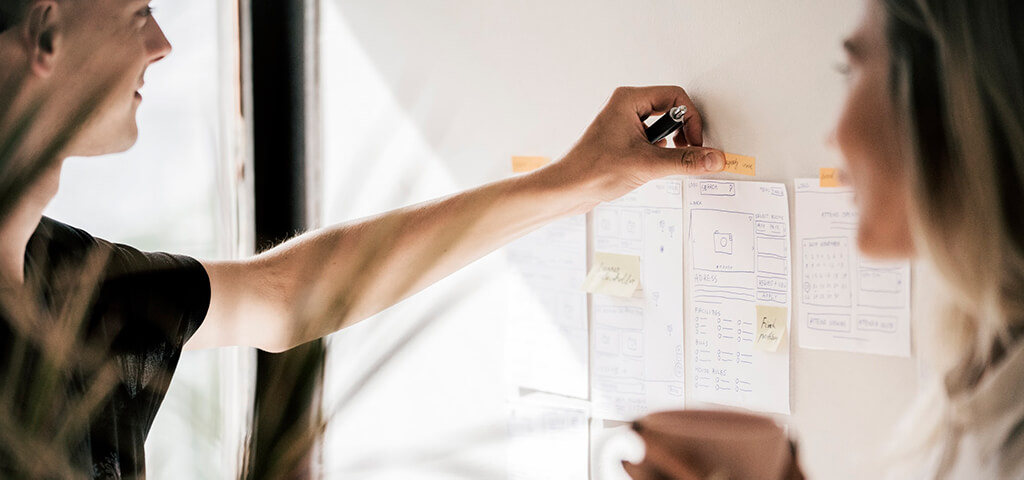Make sure you’re building the right user interface before you build it. The old adage, "Measure twice, cut once" applies to digital projects, as well.
In this post, I'll explain the value of having a user experience designer from the perspective of our own process at Bitovi.
It can be difficult to see the value of user experience design. After all, it's possible to build an app without a dedicated designer, but it's not possible to do it without a developer. And so UX design is often seen as an extra, non-essential nice-to-have. A common response is, "We are already behind on this project. We need to go straight to development."
This viewpoint is rightly focused on delivering products, but it is a fallacy to think UX design requires more time, costs more money, or is non-essential. The opposite is true: getting the design right up-front can shorten your release cycle, save you money on development, and result in a better product that is easier to use. This is what we do at Bitovi.
Consider this: your app will be designed one way or another, perhaps intentionally by a skilled designer or less purposefully by a developer making their best guess. Skilled designers create more than just pretty pictures; they have expertise in usability, access to research methods, and understand the best practices that go into making an app simple and easy to use.
Imagine building a house with all carpenters and no architect. Even if they draw their own blueprints, it will get costly as they realize their mistakes. "We originally thought the bathroom should go here, but now we realize why that doesn't work and we have to re-plumb the entire house." Our UX team can help you avoid mistakes like this.
Design is Cheaper
![]() The cost of hiring a designer is often less than the cost of hiring a developer. Since your application will be "designed" whether you have a dedicated UX designer or not, it's more economical to assign these tasks to someone who specializes in setting requirements. The cost of changing a wireframe or prototype by a UX designer is significantly less than refactoring your app after it's been built. Dedicated designers can iterate more quickly and efficiently than someone else on your team.
The cost of hiring a designer is often less than the cost of hiring a developer. Since your application will be "designed" whether you have a dedicated UX designer or not, it's more economical to assign these tasks to someone who specializes in setting requirements. The cost of changing a wireframe or prototype by a UX designer is significantly less than refactoring your app after it's been built. Dedicated designers can iterate more quickly and efficiently than someone else on your team.
Fewer Meetings
![]() Using a UX designer also saves everyone time in meetings discussing requirements, because a designer can bring wireframes and prototypes that visually demonstrate the app before any code has been written. A UX designer can quickly create mockups to show what the app will be like, without having to discuss it each time, write lengthy requirements, or have the same conversations over and over again. The designs should be well-documented and communicated to the whole team, keeping everyone in the loop and reducing meeting times.
Using a UX designer also saves everyone time in meetings discussing requirements, because a designer can bring wireframes and prototypes that visually demonstrate the app before any code has been written. A UX designer can quickly create mockups to show what the app will be like, without having to discuss it each time, write lengthy requirements, or have the same conversations over and over again. The designs should be well-documented and communicated to the whole team, keeping everyone in the loop and reducing meeting times.
Shorter Dev Cycles
![]() UX Design doesn't increase development time because it can be done in parallel. While developers are building backend services or planning architecture, the UX designer is busy creating, iterating, and testing wireframes. By the time the design is ready to be built, the developers have the technology in place to pull together the front-end quickly. Ultimately, a dedicated designer saves time by freeing the developers to focus on the technology rather than be distracted by something that isn't their core strength. And if the developers aren't solving design issues, they're free to begin development sooner. That results in faster/shorter release cycles.
UX Design doesn't increase development time because it can be done in parallel. While developers are building backend services or planning architecture, the UX designer is busy creating, iterating, and testing wireframes. By the time the design is ready to be built, the developers have the technology in place to pull together the front-end quickly. Ultimately, a dedicated designer saves time by freeing the developers to focus on the technology rather than be distracted by something that isn't their core strength. And if the developers aren't solving design issues, they're free to begin development sooner. That results in faster/shorter release cycles.
Fix It Before It's Broken
![]() A user experience designer will take the time to do usability checks on the app, either through user tests or design evaluations. This means you can find out what doesn't work before the developers start building it: try several designs without wasting resources and correct issues before they even appear. The ability of a designer to quickly iterate on prototypes means that you can make development decisions faster and have the confidence that you're building the right app to begin with. You don't have to wait until your ship date has passed to correct problems.
A user experience designer will take the time to do usability checks on the app, either through user tests or design evaluations. This means you can find out what doesn't work before the developers start building it: try several designs without wasting resources and correct issues before they even appear. The ability of a designer to quickly iterate on prototypes means that you can make development decisions faster and have the confidence that you're building the right app to begin with. You don't have to wait until your ship date has passed to correct problems.
Build it Once
![]() My dad used to say, "Measure twice, cut once". Measuring something twice costs very little compared to cutting it wrong and having to start over. When the designs are done (and done right), the developers can go straight to building the front-end without second-guessing. At this point, there isn't even much discussion. They have the designs, documented interactions, and a working prototype. All they have to do is make it work. The developers can plan their codebase right from the beginning. No more writing code, only to realize it should have been organized differently. Better-organized code has fewer bugs and is more maintainable.
My dad used to say, "Measure twice, cut once". Measuring something twice costs very little compared to cutting it wrong and having to start over. When the designs are done (and done right), the developers can go straight to building the front-end without second-guessing. At this point, there isn't even much discussion. They have the designs, documented interactions, and a working prototype. All they have to do is make it work. The developers can plan their codebase right from the beginning. No more writing code, only to realize it should have been organized differently. Better-organized code has fewer bugs and is more maintainable.
Get a Designer
When you fail to consider the experience design of your product up-front, developers will build an application based on their own intuition or the direction of the team or project manager. Those people will probably have some good ideas and the application will get done, but it will be more costly and time-consuming than it needs to be and result in an application that’s more difficult to use.
Our process at Bitovi helps guard against these costly mistakes to make sure that the app is done the right way the first time.
In part two of this post, I'll show how having a dedicated designer also saves you time and money on an ongoing basis. It's not just the initial savings that matter. The design affects the life and cost of building your product long-term.


.png)


